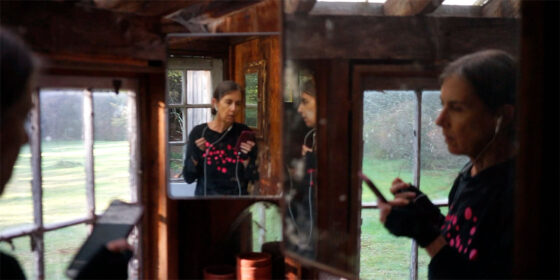TIFF 2022 | Horse Opera (Moyra Davey, US) — Wavelengths

By Michael Sicinski
An exceptionally bold programming choice by TIFF’s Wavelengths team, Moyra Davey’s feature expands on many of the conceptual tropes that have guided her photographs and video works for the past decade. In some regards a direct extension of her 2017 work Wedding Loop, Horse Opera finds the artist moving in front of and behind the frame, carefully reading out a set of biographical vignettes about the past and present of a woman called “Elle.” However, Horse Opera was made between 2019 and 2022, and is uniquely constrained by the COVID-19 quarantine. Although Davey is no stranger to enclosed domestic spaces and their semi-intentionally assembled minutiae, this work is explicitly about the divide between sociality and isolation, the home and the world.
The story of Elle involves dancing, nightlife, and the pleasures and hazards of drugs. Using the ’70s loft parties of DJ David Mancuso as a framing device, Davey explains the permutations of this social circle in lucid, supple prose. (Her flat delivery, with a pause taken between each word, accentuates the precision of the prose.) Davey describes Mancuso’s all-night dance parties as carefully curated events wherein the DJ sculpts a particular experience for his fellow revelers. As the Elle story continues, Davey describes other urban club spots, with names like Joy and The Bardo. As various figures weave in and out of Elle’s narrative, the solitary intimacy of Davey’s environment—her dusty 45s, books with cracked spines, and spiderwebs in the corners—seems both haunted and luminous.
As a contrast to Davey’s own isolation, she also shows us the land surrounding her rural home. She keeps a number of horses and ponies, and their unthinking interaction with one another, shaking off flies, nuzzling each other, and pissing in the straw, provide a stark contrast to quarantine life. For the most part, these animals’ lives have not been disrupted by COVID, and Horse Opera suggests that the virus may have returned the very idea of social interaction to something primal, a need that culture cannot satisfy. Although a basic understanding of Davey’s aesthetic project certainly deepens one’s engagement with Horse Opera, the work is relatively accessible, functioning as an introspective journal of the plague years.
Michael Sicinski

